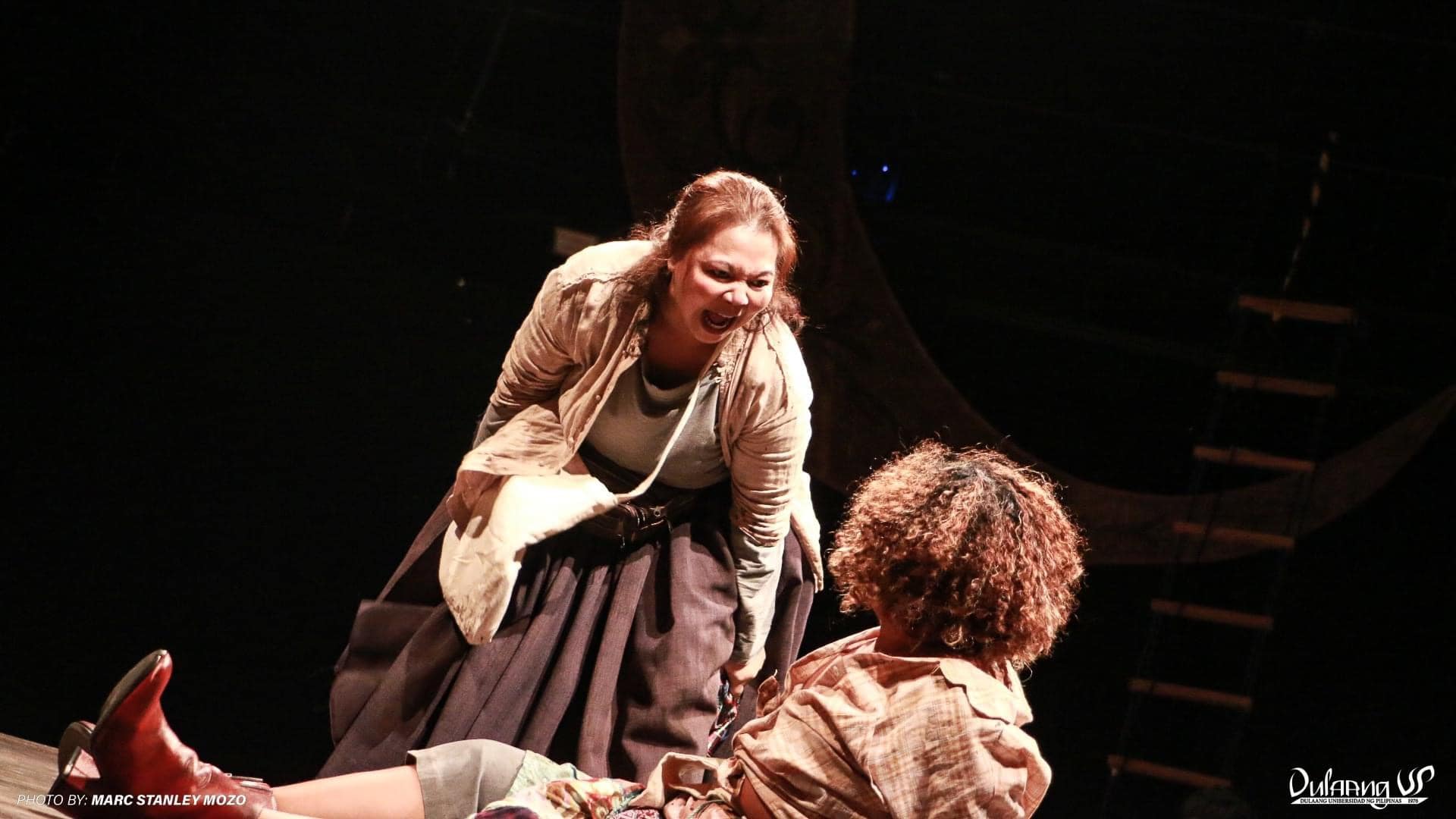
UNI-BASED REVIEW: Dulaang UP’s ‘Nanay Bangis’
DUP’s ‘Nanay Bangis’ portrays heavy historical truths in a jarringly light Brechtian display.
Dulaang UP opens its 47th season with a Filipino adaptation of one of Brecht’s most famous plays, an anti-war work written on the eve of the Nazi invasion of Poland in World War II. “Mother Courage And Her Children” becomes “Nanay Bangis” in this Rody Vera adaptation, directed by former Tanghalang Pilipino Artistic Director Herbie Go.
The play is a series of interconnected episodes strung together across many years, always with a recited caption summarizing the scene to come. It tells of a businesswoman and her three children who sell goods from a cart traversing wartorn country. Brecht’s original was set in the Thirty Years’ War, the bloodiest in Europe before 1914, but his 1941 original audience understood the play was primarily referencing the contemporary global conflict.
This echo across the centuries is paralleled in DUP’s production, with the original Catholic/Protestant conflict transposed into the Christian/Muslim narrative in 1970’s Mindanao. The play is fraught with tension, leaving audiences asking which two sides are being pitted against each other, and who stands to benefit from our continued disunity.
Unconventional Storytelling
Mark Daniel Dalacat set the stage design with a Christian cross on the ground, and a Muslim crescent moon above. “Ito’y digmaan ng pananampalataya, maganda sa pagtingin ng Panginoon,” the Christian pastor reminds us in the play.
Nanay Bangis comes onstage with children from three different fathers pulling her cart of knick knacks; selling Tanduay and weapons to both sides, loyal to none (they change the flag atop the wagon and their clothes to suit their varying Christian/Muslim customers) as they travel across Misamis Oriental, Jolo, and Zamboanga. The cart is full and heavy at the beginning, and requires Nanay’s two sons Elvis and Kesong Puti pulling the cart, with their mute sister Christine riding on it: laborers for their capitalist mother.

Ethan King as Elvis / Narrator, Khay Eva as Christine, Raymond Aguilar as Kesong Puti / Soldier; Photo Credit: Marc Stanley Mozo
The mother is sacred in Filipino culture, but Nanay Bangis is no model mom. From the very first scene, it is established that she is more mercenary than maternal, with an army recruiter successfully converting her eldest son while she prioritizes the sale of a belt buckle.
It is not a happy tale, as she loses one child after another in the never-ending pursuit of more pesos. She doesn’t want the war to end, what will happen to her business then? The daughter gets raped, but the mother encourages her to go on travelling and selling regardless, because “mababaw lang ang sugat, di pepeklat.” Perhaps one of the most chilling scenes was when Nanay Bangis pretended she didn’t recognize her son’s corpse, for fear of being arrested and forced to stop trading.
Even at the very end, she pays a family to bury her final dead child, as she is too busy hurrying after her customers, the battalion that has killed her daughter. “Sasama ka sa kanila, e sila pumatay sa kanya?” her friend asks in disbelief. “Kailangan tuloy ang negosyo,” the capitalist mother replies.
Confusing Contradictions
It was, quite frankly, bizarre.
The live band plays joyful music while the mute daughter breaks character and speaks about the vulnerability of women and children in conflict areas: a complete tonal mismatch. The scenes are broken up by concert-style songs, a mix of original tunes and Filipino folk songs with new lyrics. Lines declaring famine and massacres are recited in a deadpan, offhand manner, that they might as well have been discussing what to have for merienda.
At one point, Nanay Bangis exchanges costumes and roles with Elvis, as she sips water onstage and criticizes the length of time necessary for him to get into character (“Ang tagal! Dead air, dead air!”). Elvis asks for help from the Stage Manager (SM), saying, “Paano ito?” To which the SM replies, “Alam mo naman lines, diba?”
And just when we have gotten used to the strangeness, we get moments of sincerity, like the beautiful song with guitar and recorder, with lyrics in different Filipino languages, that would have moved this viewer deeply had I not been so confused.
Brechtian devices aside, it was an open dress rehearsal that the press were invited to and it felt like it. Sound effects were off (executions sometimes had accompanying gunfire, sometimes none), the chorus’ hums were not synchronized with the correct change in chords, actors were dropping important props in high-stakes, dramatic moments, and the student ensemble noticeably lacked commitment and energy, even when doing very basic choreography.
Focus on Brechtian Orthodoxy
The jarring tonal changes, while true to Brechtian tradition, seemed to undermine the weighty end of the play, such that when the inevitable tragedy occurs, its potentially catastrophic emotional impact was barely felt. The levity of the darkly comedic moments seemed to spill over even into the unimaginably horrific end.
The audience by then knew that our heartstrings were being pulled, and we were no longer trusting enough to fully surrender to the feeling, even in those few moments that seemed sincere.
If the production’s intention was to alienate the audience and jar it into active meaning-making, instead of “lazily” watching, then it was indeed successful. But this triumph came at the expense of the historical truth it was depicting. This viewer left the theater thinking how memorable the show is, but that its impact owes more to its storytelling technique rather than its subject matter.
Tickets: P1,000
Show Dates: November 15 – December 1, 2024 (2:30 and 7:30 pm)
Venue: Ignacio B Gimenez – KAL Theater, Magsaysay Avenue cor. Roces St., Diliman, Quezon City
Running Time: 2 hours and 5 minutes (including a 10 minute intermission)
Creatives: Bertolt Brecht (Playwright), Rodolfo C. Vera (Playwright), Issa Manalo Lopez (DUP Artistic Director), J. William Herbert Sigmund Go (Director), Angel Dayao (Musical Director / Sound Designer), Jonas Gabriel M. Garcia (Dramaturg), Popo T. Amascual (Assistant Dramaturg), Mark Daniel Dalacat (Sets & Property Designer), Tess Jamias (Movement Director/ DUP Managing Director), Barbie Tan-Tiongco (Lighting Designer), and Nicole Villanueva (Costumes Designer)
Student Creatives: Alie Ventura (Assistant Director), Phalie Medina (Production Manager), and Sophia Basco (Stage Manager)
Cast: Geraldine Villamil (Anna Perpetua a.k.a. Nanay Bangis), Air Paz (Ynez Portes / Sergeant), Ronah Rostata-de la Peña (Pedrong Tabako a.k.a. Kusinero), Fred Layno (Major / Warlord / Clerk), and Angel Manansala (Bodyguard / Peasant Woman)
Student Cast: Ethan King (Elvis / Narrator), Khay Eva (Christine), Raymond Aguilar (Kesong Puti / Soldier), Jigger Sementilla (Brother Mike a.k.a. Chaplain), Czar Bedoya (Bullet / Sergeant / Soldier), and Miel Marka El (Recruiter / Pisak / Peasant’s Wife / Matandang Muslim)
Company: Dulaang UP


Comments